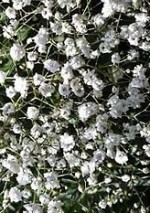 The generic name Gypsophila is derived from the Greek words Gypsos meaning lime and philos meaning love. Commonly known as baby’s breath, they derive their generic name from the fact that many of them prefer an alkaline soil. There are about one hundred different species of Gysophila including both annuals and perennials that are native to Eurasia, Africa, Australia, the Pacific Islands, with Turkey having thirty five endemic species. Gypsophila belong to the carnation family, Caryophyllaceae, that also includes pinks (Dianthus), soapwort and Lynchis. The most famous of the genus is Gypsophila paniculata, the important filler flower for florists.
The generic name Gypsophila is derived from the Greek words Gypsos meaning lime and philos meaning love. Commonly known as baby’s breath, they derive their generic name from the fact that many of them prefer an alkaline soil. There are about one hundred different species of Gysophila including both annuals and perennials that are native to Eurasia, Africa, Australia, the Pacific Islands, with Turkey having thirty five endemic species. Gypsophila belong to the carnation family, Caryophyllaceae, that also includes pinks (Dianthus), soapwort and Lynchis. The most famous of the genus is Gypsophila paniculata, the important filler flower for florists.
Plants are either upright or creeping and thrive in well-drained sweet soil and full sun to part sun. The tiny white or pink flowers are carried on slender, wiry, branched stems with linear leaves and enlarged nodes. The flowers have five notched or rounded petals and are surrounded by a calyx with white tipped green sepals. Although there are several garden worthy Gypsophilas, only four are commonly grown.
G. elegans
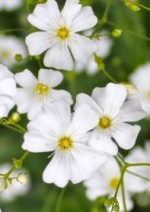 A native of the Caucasus, this short lived annual is often used as a cut flower as well as a garden plant. It tends to branch in the upper parts only and carries its single white or rose colored flowers above the foliage. Not tolerant of heat and humidity, it fades when temperatures consistently go over 85. Several good cultivars are available that vary in height and flower color.
A native of the Caucasus, this short lived annual is often used as a cut flower as well as a garden plant. It tends to branch in the upper parts only and carries its single white or rose colored flowers above the foliage. Not tolerant of heat and humidity, it fades when temperatures consistently go over 85. Several good cultivars are available that vary in height and flower color.
Type: Annual
Size: 12-16” H x 12” W
Flower Color: White, rose
G. muralis
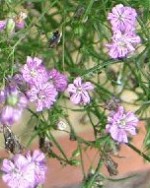 This annual is native to Europe where it grows in meadows, wastelands, roadsides, railway right of ways, fields and playgrounds. The leaves and flowers are carried on strongly branched stems and form an attractive mound.
This annual is native to Europe where it grows in meadows, wastelands, roadsides, railway right of ways, fields and playgrounds. The leaves and flowers are carried on strongly branched stems and form an attractive mound.
Type: Annual
Size: 6-12” H x 12” W
Flower Color: Pink
G.paniculata
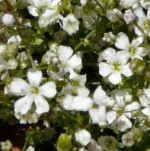 The species of florist fame, this perennial is native to Europe, and northern Asia. It has gray-green leaves and a myriad of tiny white flowers carried in frothy panicles. It can be used as a filler in the garden to take the place of fading perennials like oriental poppies and other spring blooming plants.
The species of florist fame, this perennial is native to Europe, and northern Asia. It has gray-green leaves and a myriad of tiny white flowers carried in frothy panicles. It can be used as a filler in the garden to take the place of fading perennials like oriental poppies and other spring blooming plants.
Type: Perennial
Size: 2-3’ h x 3’ W
Flower Color: White, pink, with double flowers also available
G. repens
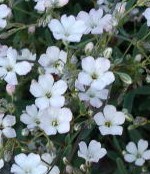 Called creeping baby’s breath, this herbaceous perennial is native the mountains of central and southern Europe where it grows on dry, chalky slopes. The trailing eighteen inch long stems with gray leaves ½-1 inch long form substantial mats in about two years. Small open flat clusters of star-shaped ¼” flowers are white to pale lilac and cover the plant in summer. Plants are more tolerant of acid soil than other plants of the genus.
Called creeping baby’s breath, this herbaceous perennial is native the mountains of central and southern Europe where it grows on dry, chalky slopes. The trailing eighteen inch long stems with gray leaves ½-1 inch long form substantial mats in about two years. Small open flat clusters of star-shaped ¼” flowers are white to pale lilac and cover the plant in summer. Plants are more tolerant of acid soil than other plants of the genus.
Type Perennial
Size: 4-8” H x 12” W
Flower Color: white to lilac but pink cultivars, including a double flowered one, are available.